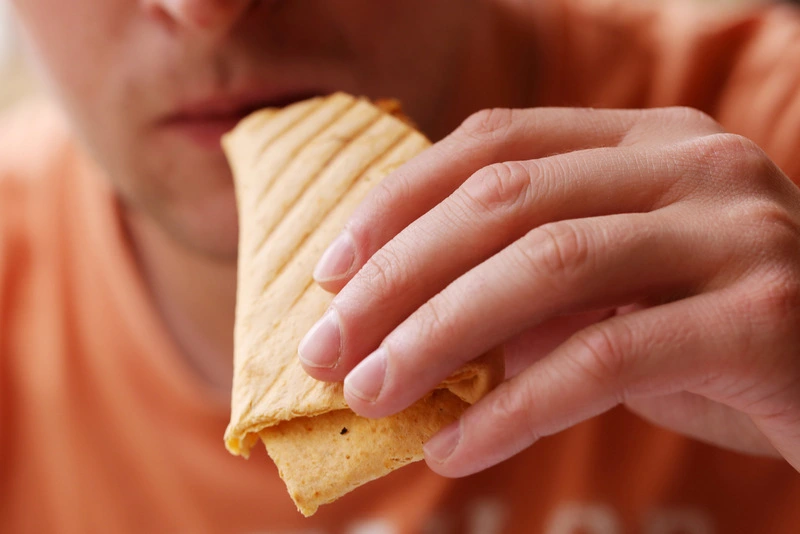This article will help examine the connection between emotional eating and eating disorders, clarifying whether emotional eating qualifies as an eating disorder and offering guidance on recognition and management.
Is emotional eating a disorder? The basics
Emotional eating is when individuals turn to food to satiate emotional distress rather than dealing with the distress in healthier fashions.
Eating disorders come in several forms and are characterized by disturbing eating patterns or eating-related behaviors, which can impair psychosocial and physical functioning. Examples include:
- Anorexia nervosa
- Bulimia nervosa
- Binge-eating disorder
- Avoidant/Restrictive food intake disorder
These conditions are defined by diagnostic criteria such as significant restriction of food or binge eating despite consequences, with no other explanation, and because of significant concern following weight loss or gain.
It’s not uncommon for legitimate eating disorders to be heavily associated with significant weight problems, nutritional deficiencies, dependence on supplements, and to interfere with psychosocial function.
So, is emotional eating an eating disorder? For an eating disorder, emotional eating does not technically qualify as a mental health issue because, while it relates to your mental state, it is not a diagnostic issue.

Emotional vs. physical hunger
What is the difference between physical and emotional hunger, and when does emotional eating become a problem?
Physical hunger
With physical hunger, individuals might go from feeling comfortable or neutral during the day to feeling physical hunger pains in their stomachs. Their stomach might start growling because there’s no food in there to be processed. Without satiation, individuals can become ravenous and unexpectedly eat more than they need until they are bloated and nauseated.
Physical hunger has direct correlations to physical activity and different times of the day. Most people are hungry when they wake up because they haven’t eaten at night, just as most people get hungry after they work out.
With physical hunger, people are more likely to crave healthy foods, something full and satisfying. If it’s cold out, they might crave a heavy stew or chili; in the middle of summer, they might crave a light salad or a refreshing fish dish.
Emotional hunger
With emotional hunger, people don’t feel the physical pain of hunger or the growling in the stomach. In fact, they might already be full or stuffed, but they feel the need to continue eating for emotional reasons. It could be that:
- The physical act of eating brings them comfort
- It gives them something to do
- It helps them avoid negative feelings
- It is a distraction
With emotional hunger, people crave things that directly influence things like the nervous system. This can include sugars, fats, and simple carbohydrates like pasta, pastries, or bread. These foods are more likely to slow down the nervous system and help control things like stress.
Emotional eating can happen on occasion. Perhaps someone in grief after the loss of a loved one indulges in too many “comfort foods,” but that goes away. It becomes a problem when it’s a consistent pattern that happens every day, several days, or weeks in a row.

Is emotional eating an eating disorder?
There is much debate around the classification of emotional eating as a mental health disorder. Some arguments are that emotional eating has similar criteria to things like restrictive food intake or binge eating, where an individual uses food as a form of escapism or self-medicating. However, at this time, the answer to “Is emotional eating a disorder?” is “no.”
– Arguments in favor
Some arguments in favor of classifying emotional eating as a disorder state that the cyclical nature of emotional eating leads to guilt and more eating, with the potential for it to escalate to conditions like binge eating disorder. It also shares many similarities to recognized eating disorders like binge eating disorder, bulimia, and night eating syndrome.
– Arguments against
The viewpoint against the classification is that it’s a coping mechanism, not a disorder in itself. It is different from clinical eating disorders in terms of intensity and frequency and could, in theory, be more readily and easily controlled or stopped.
Strategies to combat emotional eating
Just because the answer to “Is emotional eating an eating disorder” is “no” does not mean that emotional eating should not be taken seriously. If you or someone close to you is struggling with emotional eating, there are some strategies you can use to combat it:
– Mindful eating: being present during meals and understanding hunger cues
In Japanese culture, there is a mantra used during meal times by about 80%. This is meant to signal you to stop eating when you feel 80% full. This type of mindfulness relates to hunger cues.
The body takes an average of 20 minutes to fully digest a meal. It is for this same reason that children are advised against swimming or engaging in other strenuous cardiovascular work until at least 20 minutes after eating.
However, this means that it can take up to 20 minutes for the signals to tell you that you are full and don’t need more food to reach your brain. If you are mindful of this while you eat and stop when you feel 80% full, then wait for 20 minutes, you can stop yourself from overeating.
Tangentially, being mindful while you eat is important. This is also referred to as eating meditation. For this to work effectively, you should avoid distractions while eating, like watching television. At the very least, you should be mindful of each bite you take, how many times you chew before you swallow, and doing things like putting your cutlery down in between bites to encourage you to slow down.
The average person consumes ⅓ more than they need at each meal if they eat mindlessly while watching TV.

– Therapy and counseling
With therapy and counseling, you have a chance to unpack emotional triggers with professional help. This makes it easier to identify when you normally rely on emotional eating and learn to replace those habits with better techniques.
– Stress-reduction techniques: meditation, exercise, journaling.
These better techniques involve stress-reduction techniques like meditation, exercise, and journaling. Simple things like journaling can help you recognize your emotions and learn to sit with them rather than try avoiding them with food. Exercise and meditation can help you recognize how you are feeling and why you are feeling that way, and even boost your mood so that you don’t need to overeat or indulge in unhealthy foods.
– Balanced diet
If you are struggling with any form of eating disorder or emotional eating, it’s essential that you work with professionals to learn how to achieve a balanced diet. You want to ensure that your emotional cravings don’t result in nutritional deficiencies.
– Support groups
Several support groups are available throughout the country to help people with eating disorders or emotional eating problems. The support groups offer a chance to socialize with people going through similar situations, share, and learn from one another.
Summing Up
Recognizing and addressing emotional eating as a legitimate mental health problem is essential, even if it’s not categorized as an eating disorder. Understanding your relationship with food and emotions will help you develop healthy coping mechanisms regardless of the official classification. Don’t be afraid to reach out to a therapist or support groups in your area.



